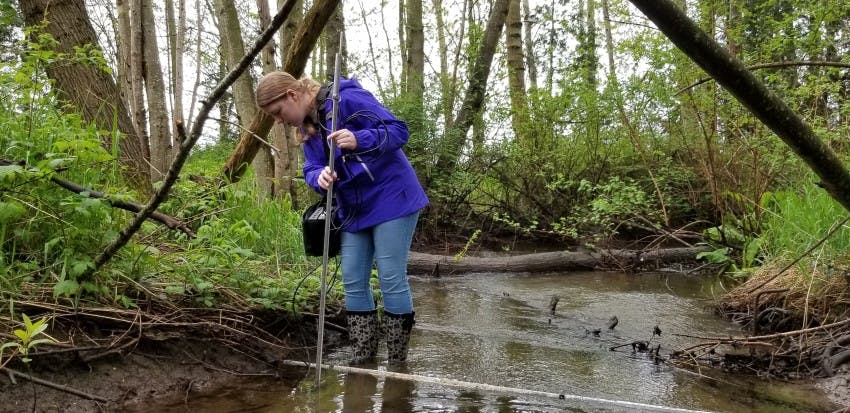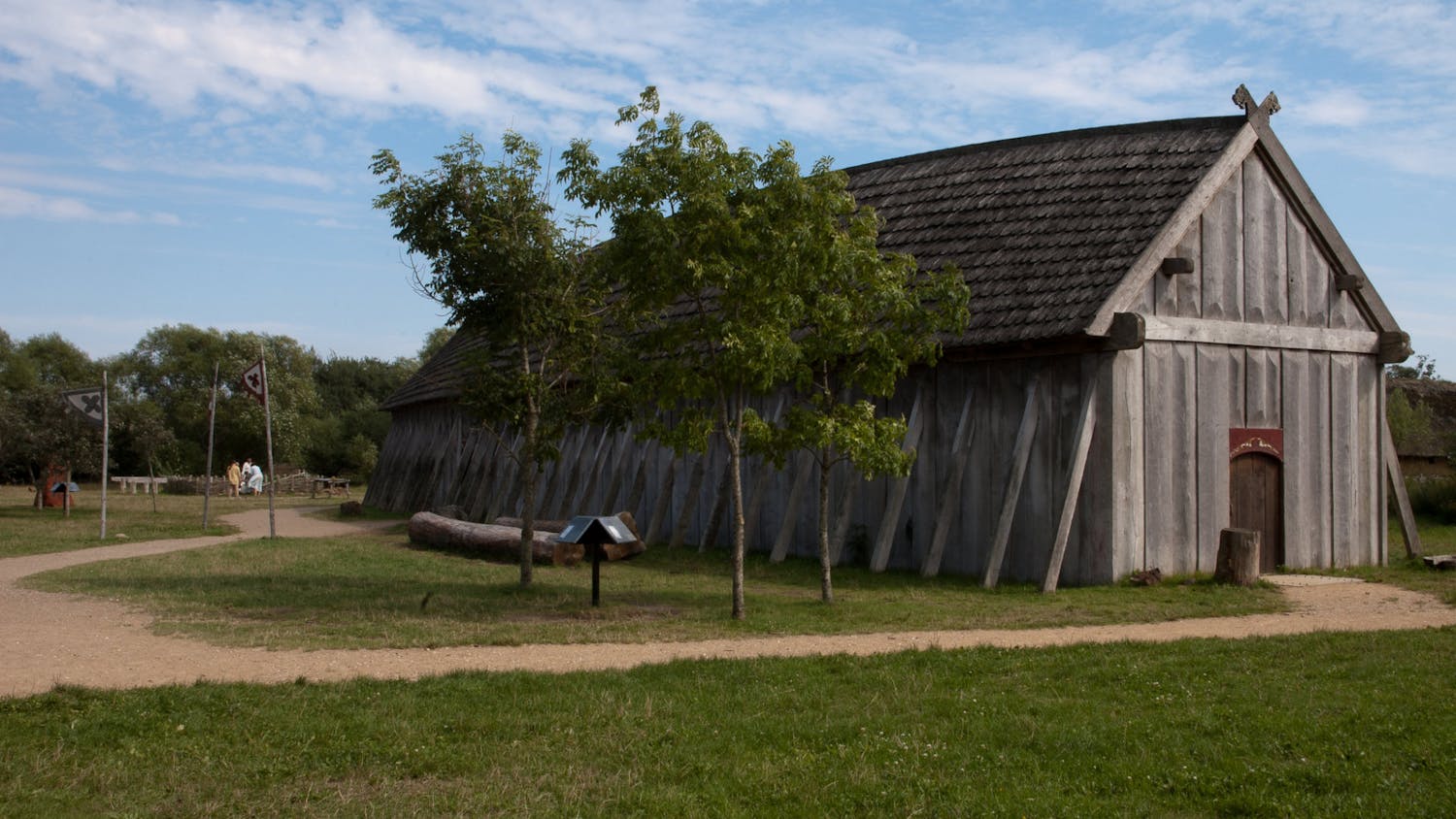
Undergrad student Hailey Dearing doing field research in Schell Creek for Professor David Hooper’s lab class. Dearing samples streamflow in a restored part of one of the test watersheds. // Courtesy of David Hooper
Western Washington University professor of biology, David Hooper, received a $30,000 grant to conduct research on the links between policy and riparian restoration for nutrient retention in the Nooksack River watershed. He’s conducting this research along with two first-year graduate students majoring in biology, Astoria Tershy and Patrick Damaree in collaboration with Amanda Stahl, a post doctorate at Washington State University.
Tershy, who is studying riparian buffers, said these areas of vegetation alongside waterways are really special because they have the capacity to intercept and retain nutrients which prevents those nutrients from entering into waterways and polluting them.
Hooper said their research began over 15 years ago and in the early stages was focused on riparian restoration in the Nooksack watershed and on salmon habitat in particular. He said it was driving their research because there were several threatened and endangered runs of salmon.
Hooper said that for the past five or six years they have been looking at the effectiveness of the riparian buffers and where they’re placed in relation to in-stream habitat conditions and water quality, specifically looking at plant effects on nutrient cycling.
To do this, Hooper said they collect field data and compare them to models they have created to test scenarios and figure out the best way to improve water quality.
If the riparian buffers are not effective, more nutrients are able to get into streams which Hooper said will then end up in Bellingham bay and cause eutrophication. Eutrophication is when a body of water becomes progressively enriched with nutrients which can cause ecological degradation.
To conduct this research, Hooper put together a detailed proposal for the State of Washington Water Resource Center for their “seed” grant projects. The proposal explained why the topic is important, what they expect to learn from it and how they plan on carrying out the research including who is going to do it, where and when.
Jonathan Yoder, the director of the State of Washington Water Resource Center and professor of economic sciences at Washington State University, said their center is one of 54 National Institutes for water resources through the U.S. which are supported by a federal program under the Water Resources Research Act of 1964.
“The idea of these seed grant programs is to fund new ideas and research agendas that are unique, cutting edge, to help get these ideas off the ground in an exploratory way that provides a foundation for going after more research support through bigger grant programs to expand the work even further,” Yoder said.
Yoder said the center’s Science Advisory Committee, which is made up of nine people from various disciplines, reviews all proposals and ranks them based on their quality and then holds a meeting to discuss the strengths and weaknesses of each proposal.
“We have people from a very wide range of expertise and background so that we have somebody who is a specialist in virtually any topic … So we get a lot of diversity of opinions about papers,” Yoder said.
Yoder said each year the committee usually receives between eight submissions to as high as 15 submissions, and three of them are granted $30,000. Each research team has a year to use the money and then needs to submit a report around three months after the funding period explaining the research that they have accomplished in that time.
“They're relatively small grants, about $30,000 per project, which might sound like a lot,” Yoder said, but he said research is an expensive enterprise where the money goes to support graduate students, faculty salaries, field work, data collection and technology needs.
Yoder said Hooper's proposal is one that has a solid connection between riparian habitat science and policy in the form of prioritization of riparian buffer management. He said he finds projects that link science and policy particularly compelling.
Policy as defined by Yoder: “Decision making,” “An instrument of public rule or administrative guidelines that provides support or mandates for something.”
Hooper said the $30,000 will go in part to support Tershy and Demaree in a research assistantship which will help pay for their living expenses and tuition for graduate school so they are able to fully focus on their research. This is different from teacher assistantships, which most graduate students are supported by, where they are paid to help professors run labs and must then divide their time between work, class and research.
“I’m just really excited for the opportunity to focus all my energy on research, and I'm really excited to see where this project goes,” Tershy said.
Hooper said the other part of the funding will go toward supporting the salary of Amanda Stahl for working on the policy aspect of the research on riparian restoration for nutrient retention in the Nooksack River watershed.
“If we don't have policy that aligns with accomplishing the economic and environmental goals that we’re after, then the best science in the world isn't gonna help you meet those goals,” Hooper said.
Tershy said much of her research time goes toward mapping all of the buffers in the Nooksack watershed and running a model to try and estimate the total amount of nitrogen the buffers have obtained.
Demaree said his work focuses on a specific model called the APEX model [Agricultural Policy/Environmental eXtender] developed by the U.S. Geological Survey and that he’s capitalizing on some previous work that graduate students in Hooper’s lab have done with the model attempting to produce accurate estimates of the nutrients entering Kamm Creek in the Nooksack watershed.
Hooper said they work a lot with the office of Research and Sponsored Programs as well and that Western has great people to help them put together budgets for their research.
“In the big picture, I think this is a good example of how research in Western ties into serving important issues that are out in the community and in both doing fundamental science but also then doing some real world problem solving,” Hooper said. “Our research is tied into some broader efforts in the Nooksack basin to help improve water quality.”
For more information check out the Water Research Center Website.
Gaia Crans (he/him) is the special projects editor for The Front. He is a senior news/editorial journalism student with a minor in sociology. When he’s not writing or stressing over the existence of the Oxford comma, Gaia enjoys climbing at Vital or spending time outside with his dog, Nova.
You can find him and pictures of his adorable pup on Instagram @captaingooya or contact him at gaiacrans.westernfront@gmail.com.





